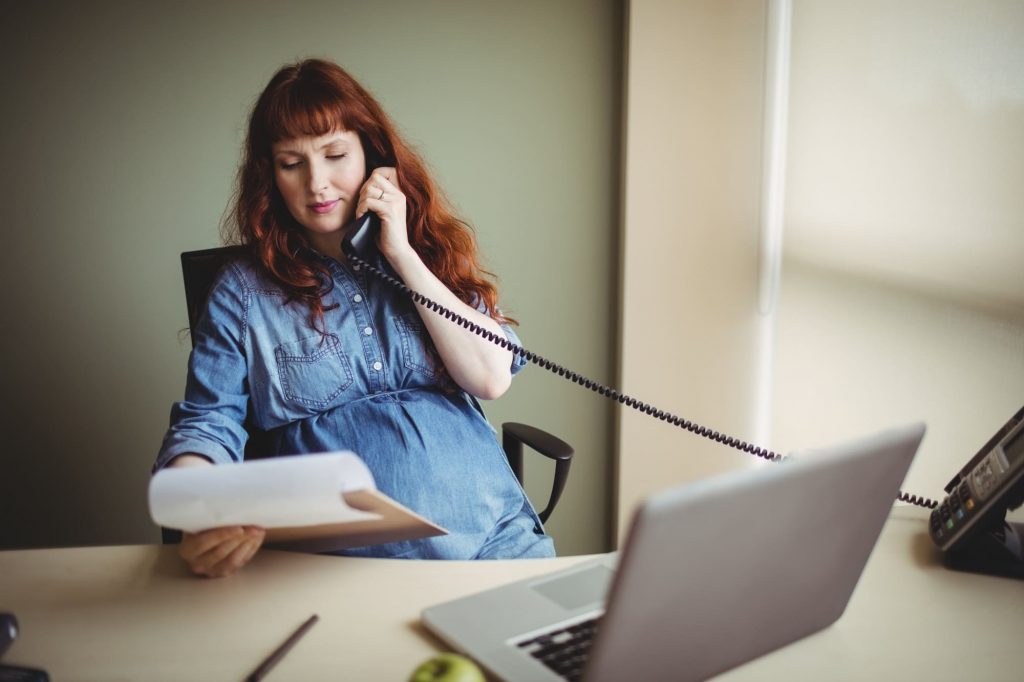An Employee's Guide to Pregnancy Disability Leave And Bonding Leave In California

Welcoming a new child into your family is usually an exciting time. But it can also be stressful — especially if you’re worried about how it will impact your job.
Women often need to take time off during pregnancy or after giving birth to protect their health.
And all parents and children can benefit from time to bond, especially in the early months.
Of course, if you’re afraid of losing your job, you’re much less likely to take off the time you need.
California has some of the most extensive leave laws in the country. As an employee in the state, you may be eligible for:
- pregnancy disability leave,
- bonding leave, and/or
- “reasonable accommodation” leave.
This guide can help you understand your options.
What is pregnancy disability leave?
Pregnancy disability leave is time off from work that a woman takes when she’s disabled by pregnancy or childbirth.
In California, you can take pregnancy disability leave under two laws:
- the Pregnancy Disability Leave Law, or PDL Law; and
- the federal Family and Medical Leave Act, or FMLA.
The PDL Law is part of the Fair Employment and Housing Act, or the FEHA. The FEHA is California’s anti-discrimination law.
Pregnancy Disability Leave under the PDL Law
The PDL Law provides for up to four months of pregnancy disability leave. 1The exact amount of leave depends on how many hours a week you work.
You have a right to leave under the PDL Law if 1) you have a pregnancy disability and 2) your employer is covered by the PDL Law. You can take leave even if you’re a part-time employee. 2 And you don’t have to work a minimum number of hours per year, either. 3
Your employer is covered by the PDL Law if it:
- has at least 5 employees,
- is an agent of a covered employer, or
- is a state or local government entity. 4
Note that religious non-profit organizations are not subject to the PDL Law.5
But what if you don’t need to take all four months of pregnancy disability leave all at once?
The PDL Law allows you to take pregnancy disability leave “intermittently.” 6“Intermittent” leave means taking leave for a few hours, days, or weeks at a time.
Pregnancy Disability Leave under FMLA
FMLA provides for up to 12 weeks of leave. This leave may consist of pregnancy disability leave and/or bonding leave. You may also be able to take leave to care for your pregnant spouse if she has a serious health condition. 7
If you’re eligible for pregnancy disability leave under both the PDL Law and FMLA, your leave will run at the same time. 8This means you’ll only get up to four months total of pregnancy disability leave under both the PDL Law and FMLA.
To qualify for pregnancy disability leave under FMLA, you must:
- have a serious health condition related to pregnancy; 9
- have worked for your employer for at least one year; and
- have worked at least 1,250 hours in the year before your leave.10
Your employer also must have at least 50 employees working within a 75-mile radius of you. 11
Unlike the PDL Law, you can only take intermittent leave under FMLA if 1) it’s medically necessary, or 2) your employer consents.12
Defining Pregnancy Disabilities
Pregnancy and childbirth are very physically demanding. But pregnancy itself isn’t a “disability” or “serious health condition” for purposes of taking leave.
So how do you know if you have a qualifying condition?
In California, you have a “pregnancy disability” or “serious health condition” if, in your doctor’s opinion, you’re unable to perform any essential job functions because of your pregnancy. 13
There are many types of pregnancy disabilities. Common examples include, but are not limited to:
- severe morning sickness,
- need for bed rest,
- gestational diabetes,
- pregnancy-induced hypertension,
- preeclampsia,
- postpartum depression,
- recovery from childbirth, and
- recovery from end of pregnancy.14
What is bonding leave?
Bonding leave is time an employee takes off from work to bond with a new child. You may have also heard it called “parental leave.”
Eligible employees can take bonding leave within the first year of a child’s arrival — whether by birth, adoption, or foster placement.15
In California, the following laws provide for bonding leave:
- the California Family Rights Act, or the CFRA;
- California’s New Parent Leave Act, or NPLA; and
- FMLA.
The CFRA and NPLA are state laws that provide for up to 12 weeks of bonding leave. Under NPLA, bonding leave may only be 12 weeks total for both parents if they have the same employer.
FMLA is a federal law that provides for up to 12 weeks of pregnancy disability leave and/or bonding leave.
The CFRA and FMLA both cover employers with at least 50 employees working within a 75-mile radius. To take leave under the CFRA or FMLA, you must:
- have worked for your employer for at least one year; and
- have worked at least 1,250 hours in the year before your leave.
NPLA has the same requirements, except it applies to employers with at least 20 employees.
The availability of bonding leave means women with pregnancy disabilities can get up to seven months of leave. This would consist of:
- up to four months of pregnancy disability leave under the PDL Law and FMLA, followed by
- up to 12 weeks of bonding leave under the CFRA or NPLA.
You can take bonding leave under the CFRA or NPLA intermittently — so long as you complete it within one year of your child’s arrival. But other than on two occasions, your employer may require you to take your leave in blocks of at least two weeks.
Under FMLA, you’ll need the approval of your employer to take intermittent bonding leave.
When are you entitled to “reasonable accommodations”?
Under the FEHA, covered employers must provide “reasonable accommodations” for disabled employees — including those disabled by pregnancy.
An employer is generally covered by the FEHA if it has 5 or or employees.
A “reasonable accommodation” is a change to your position or workplace to help you perform your essential job functions.
The accommodations that you’re entitled to depend on your disability and your job. Examples include:
- changing work practices or policies,
- changing work duties,
- changing work schedules,
- providing more breaks,
- providing a stool or chair, and
- providing facilities for private lactation.
Notably, “reasonable accommodation” may also mean time off from work. “Reasonable accommodation” leave may be possible even after you’ve used up other types of leave.
Your employer doesn’t have to provide an accommodation that would:
- cause your employer undue hardship,
- prevent you from performing your essential job functions, or
- threaten the health of you or your coworkers.
What is considered “undue hardship” depends on the employer and the accommodation. But generally it means any action that is significantly difficult or expensive.
Will you be paid during pregnancy disability leave and/or bonding leave in California?
Your employer is generally not required to pay you during your leave. San Francisco does have a paid parental leave ordinance covering certain employers.
You may also be able to recover some pay through:
- California’s disability insurance (DI) program. California’s DI program may pay some of your usual wages while you’re temporarily disabled.
You may be eligible if:
- you have a short-term pregnancy disability, and
- you earned at least $300 subject to state disability insurance (SDI) tax during your base period.
Your “base period” is about 5 to 18 months before you became disabled.
- Temporary disability pay. Sometimes employers voluntarily pay temporary disability leave. If your employer does this, it may have to pay you during pregnancy disability leave.
- Vacation time, sick leave, or other paid time off. During your pregnancy disability or bonding leave, you have the right to use any accrued:
- vacation time,
- sick pay, or
- other paid time off.
If you take bonding leave, your employer can force you to use any accrued paid or unpaid time off.
Under the PDL Law, your employer can only force you to use sick leave during disability leave.
You should check with your employer to confirm its policies.
- California’s paid family leave fund. Under this program, you may receive partial wages from the state during your leave.
If you qualify, the state will pay 60-70% (depending on your income) of your wages for six weeks, subject to a maximum set by law. In 2019, the weekly maximum was $1,252.
You may be eligible if you earned at least $300 subject to SDI tax during your base period. Your “base period” is the 5 to 18 months before you file your claim.
You don’t need to be disabled to qualify. And you can still receive paid family leave benefits if you aren’t legally entitled to time off. This may be the case if, for example, your employer has fewer than 20 employees.
But remember that this program does not provide job protection — you’ll need to look to the CFRA, NPLA, or FMLA for such protection.
- Employer-Provided Disability Insurance. Although not required, many employers offer private short-term and/or long-term disability insurance. If you have this insurance through your employer, it may cover lost wages during pregnancy disability leave. You usually have to file your claim promptly. And there may also be a waiting period before receiving payments. If you plan to use disability insurance during your leave, you should read your policy carefully. You may also want to consult an attorney.
Will you still receive health benefits during pregnancy disability leave and/or bonding leave in California?
If you qualify for pregnancy disability leave or bonding leave, your employer generally must maintain your usual health benefits.
This means your employer must pay the same premiums that it paid while you were working. It’s also illegal for your employer to impose new requirements for benefits when you return from leave.
How do you take pregnancy disability leave or bonding leave in California?
Notice for Pregnancy Disability Leave
If your need for pregnancy disability leave is foreseeable, you should give your employer at least 30 days’ notice. Otherwise, you should give as much notice as practicable.
Your employer may require a written certification from your doctor stating that:
- you’re disabled by pregnancy, childbirth, or a related medical condition, and
- you need to take pregnancy disability leave.
If you give proper notice and medical documentation, your employer can’t deny you pregnancy disability leave. It also can’t deny you leave because of an unforeseen medical emergency relating to pregnancy or childbirth.
Notice for Bonding Leave
If you want to take bonding leave under the CFRA or NPLA, you should give your employer reasonable notice.
Your employer may require you to give at least 30 days’ notice when your need for leave is foreseeable. But if your need for bonding leave is unexpected, you should give notice as soon as practicable.
To take bonding leave under FMLA, you should give your employer at least 30 days’ notice. If your need for leave is not foreseeable, you should give as much notice as practicable.
It’s a good idea to give your notice in writing. The notice should state:
- when you expect to take leave;
- how long you expect to take leave; and
- your reasons for taking leave (so that your employer knows you’re taking bonding leave).
If your employer asks questions designed to confirm whether you qualify for leave, you should answer them.
Can you lose your job if you take pregnancy disability leave or bonding leave in California?
The right to take leave doesn’t mean much if you don’t have a job when you return.
In California, when you return from leave your employer must give you the same or a comparable position (unless certain exceptions apply).
Most employees can return to their old position. But sometimes that’s not possible. In that case, your employer may give you a “comparable” position. Your new position should be the same or similar in:
- pay;
- benefits;
- shift;
- schedule;
- geographic location;
- working conditions, including privileges, perquisites, and status; and
- duties and responsibilities.
Your employer can’t demote you if your old position isn’t available. But if your employer offers a new position with better pay, benefits, or opportunities, you may decide to accept it.
In limited circumstances, your employer may lay you off during your leave. This may happen if, for example:
- your employer conducts layoffs for legitimate business reasons;
- your employer already planned to cut your position for a reason unrelated to your leave; or
- no comparable position is available.
These situations are rare. Your employer can’t deny you reinstatement just because it would be inconvenient.
If you’re laid off and you’re not sure it’s legal, you should contact an experienced employment attorney right away.
Is Your Employer Treating you Wrongfully Due to Your Pregnancy or Maternity Leave?
Just remember California has powerful laws in place to protect you. You don’t have to live with an abusive situation.
In most cases, it’s better not to deal with a sexual harassment claim on your own. An experienced California employment attorney can help you:
- organize the facts of your case
- counsel you in knowing all your options
- navigate complicated legal procedures
- craft strong legal arguments
- maximize financial damages
Questions About Your Pregnancy/Maternity Leave Claim?
At Whitehead Employment Law, we’re committed to fighting for the rights of California employees just like you. If you believe you’re a victim of harassment, wrongful termination retaliation due to your pregnancy or maternity leave, call us at (949) 936-4001 or fill out a confidential case evaluation form today. Our consultations are always free.
SWemploymentlaw is a premier firm with a wealth of legal talent dedicated to labor and employment law. We have settled and tried cases winning millions of dollars in awards for clients whose employers have violated California labor laws.
We take our cases on a contingency basis, which means we don’t get paid unless we win the case for you. We also front all the court costs and fees, and get paid our share out of the court verdict or settlement with the employer if we win the case, so you don’t pay anything out of pocket.

